Your tyranny of low expectations is showing and SURVIVORS WANT 100% RECOVERY! GET THERE! 'Care' is NOT what survivors want, so first you have to set the right goals for the WSO!
Stroke is a treatable disease and telehealth can support patients, say Neurologist Sheila Martins & Carla Goulart Peron, Chief Medical Officer at Philips
Ischemic strokes are caused by a blocked blood vessel and they are treatable, even reversed if treatment is immediate(YEAH IF TREATMENT IS WITHIN 3 MINUTES IN RESEARCH IN MICE. Think your hospital can do that? So by definition you are wrong, stroke is NOT treatable to 100% recovery; lesser goals than that are not supported by survivors!)
The 3 minute research here:
Electrical 'storms' and 'flash floods' drown the brain after a stroke
Strokes are sometimes seen as a consequence of unhealthy lifestyles which can be tackled by prevention. But that's not the only option - patients deserve preventive care as well as treatment, because a stroke is a curable disease.
Despite the latest guidance from the World Health Organization (WHO), this is not yet the norm in the global healthcare sector.
Sheila Martins, neurologist and outgoing President of the World Stroke Organization (WSO) and Carla Goulart Peron, Chief Medical Officer at Philips, want to ensure that the voices of stroke patients are heard.(Hey, contact me at oc1dean@gmail.com You'll get an earful) Here they discuss the investment required to facilitate access to treatments that can cure it.

Philips advocates for advanced stroke treatments worldwide
Carla and Sheila have been working together for years to improve healthcare for stoke patients. Previously, Carla was assigned to support one of Sheila’s studies to prove that better stroke care(NOT RECOVERY!) could be delivered in the country’s public health service.
“During that period, the standard treatment for most stroke patients in small towns or rural areas was taking an aspirin once a day,” she reflects. “I remember thinking to myself that it would be quite a leap from that situation to build the required expertise and infrastructures to offer thrombolysis. But thanks to her determination, Sheila made important steps towards making stroke a very treatable disease in Brazil.”
It took years from one aspirin a day to the use of thrombolysis in
stroke care(NOT RECOVERY!). Now, limited investment in stroke care means it is only
offered to 3% of the world’s stroke patients that meet the eligibility
requirements.
The World Health Organization has said that the treatment is available for just 41% of countries. Sheila fears that we may be at risk of allowing a similar situation to arise for another game-changing procedure, mechanical thrombectomy, a minimally invasive procedure which removes blood clots via a catheter inserted through the patient’s arteries.
“I recently spoke to a representative from Indonesia’s Ministry of Health, who told me he had 16,000 islands under his administration. If telehealth and AI could help to decide where to send the helicopter to pick up the patients most in need, that would make the job a whole lot easier,” added Carla.
For Sheila, it is strong partnerships and a coordinated advocacy programme which will bring stroke to the front of global healthcare concern.

Telehealth is fundamental to advancing stroke care(NOT RECOVERY!)
According to Sheila, there is insufficient focus on research funding and healthcare expenditure to really advance acute stroke care(NOT RECOVERY!).
“Stroke is the leading cause of disability and is increasingly affecting younger people. Investing in acute stroke treatments provides governments with an unmissable opportunity to reduce the burden of stroke on individuals and society and deliver on their commitment to provide health and well-being for all,” she says. “The payback in terms of increased GDP productivity and reduced long-term care costs far outweighs the initial investment.”
Acute stroke care(NOT RECOVERY!) requires two things: diagnostic imaging for precision diagnosis and a highly skilled healthcare workforce. Sheila believes that technologies like telehealth and AI can help to reduce costs, as well as increase diagnostic accuracy.
“Telehealth is fundamental to advancing stroke care(NOT RECOVERY!), allowing specialists to advise less experienced staff how to treat each patient,” she says. “Artificial intelligence to rapidly identify ischemic stroke, hemorrhagic stroke or large vessel occlusions, or assist in deciding which patients need to be transferred to a comprehensive stroke centre will also play a part.”
No comments:
Post a Comment